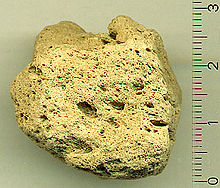This is an old revision of this page, as edited by 142.68.144.76 (talk) at 18:25, 26 October 2011 (→Properties). The present address (URL) is a permanent link to this revision, which may differ significantly from the current revision.
Revision as of 18:25, 26 October 2011 by 142.68.144.76 (talk) (→Properties)(diff) ← Previous revision | Latest revision (diff) | Newer revision → (diff)
Pumice /ˈpʌms/ is a textural term for a volcanic rock that is a solidified frothy lava typically created when super-heated, highly pressurized rock is violently ejected from a volcano. It can be formed when lava and water are mixed. This unusual formation is due to the simultaneous actions of rapid cooling and rapid depressurization. The depressurization creates bubbles by lowering the solubility of gases (including water and CO2) dissolved in the lava, causing the gases to rapidly exsolve (like the bubbles of CO2 that appear when a carbonated drink is opened). The simultaneous cooling and depressurization freezes the bubbles in the matrix.
Uses
Pumice is widely used to make lightweight concrete or insulative low-density breeze blocks. When used as an additive for cement, a fine-grained version of pumice called pozzolan is mixed with lime to form a light-weight, smooth, plaster-like concrete. This form of concrete was used as far back as Roman times. Roman engineers used it to build the huge dome of the Pantheon and as construction material for many aqueducts.
It is also used as an abrasive, especially in polishes, pencil erasers, cosmetic exfoliants, and the production of stone-washed jeans. "Pumice stones" are often used in beauty salons during the pedicure process to remove dry and excess skin from the bottom of the foot as well as calluses. It was also used in ancient Greek and Roman times to remove excess hair. Finely ground pumice is added to some toothpastes and heavy-duty hand cleaners (such as Lava soap) as a mild abrasive. Pumice is also used as a growing substrate for growing horticultural crops.
References
- Sherrow, V. 2001. For appearance' sake: the historical encyclopedia of good looks. Greenwood, 312pp. ISBN 1-57356-204-1
External links
- University of Oxford image of pumice. Retrieved 2010-09-27.
- Analytical identification of a single source pumice from Greek shores and ancient sites in the Levant.
- On the occurrence of a pumice-rich layer in Holocene deposits of western Peloponnesus, Ionian Sea, Greece. A geomorphological and geochemical approach.